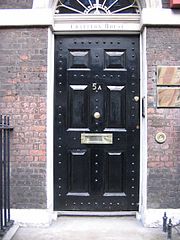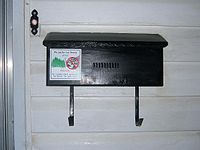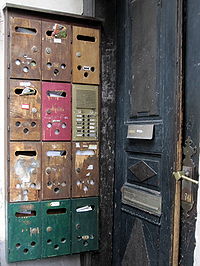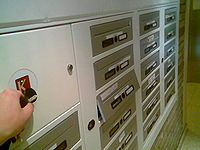- Letter box
-
This article is about boxes for depositing letters. For video framing, see letterbox. For the type of interprocess communication, see MailSlot .
A letter box, letterbox, letter plate, letter hole, mail slot, or mailbox is a receptacle for receiving incoming mail at a private residence or business. For the opposite purpose of collating outgoing mail, a post box is generally used instead.
Letterboxes or mailboxes consist of four primary designs:
- a slot in a wall or door through which mail is delivered
- a box attached directly to the house
- a box mounted at or near the street
- a centralised unit consisting of many individual mailboxes for an entire building or neighbourhood
Contents
Styles and usage
A mail slot (American usage) or letterbox (British usage) is a slot, usually horizontal but sometimes vertical, about 30 cm by 5 cm (12 inches by 2 inches), cut through the middle or lower half of a front door. This style is almost universal in British homes and offices, but in the U.S.A is primarily found in older neighborhoods and on the east coast of the country. Most are covered by a flap on the outside for weatherproofing. The flap may be closed by gravity, or sprung to prevent it opening and closing noisily in the wind. Some letterboxes also have a second flap on the inside to offer further protection from the elements. There may also be a small cage or box mounted on the inside of the door to receive the delivered mail.
Wall-mounted or 'attached' mailboxes may also be used in place of mail slots , usually located close to the front door of the residence. Attached mailboxes are common in urban and older suburban neighbourhoods and in high-density neighbourhoods in North America. They are especially common in urban and suburban areas of Canada, where the curbside mailbox is rarely seen except in rural areas. Attached mailboxes are less common in newer developments and in smaller towns and cities where mail is distributed through a combination of post office boxes and community mail stations.
Rural and some suburban areas of North America may utilize curbside mailboxes. These receptacles generally consist of a large metal box mounted on a support designed primarily to receive large quantities of incoming mail, often with an attached flag to signal the presence of outgoing mail to the mail carrier. In the U.S. and Canada, rural curbside mailboxes may be found grouped together at property boundaries or road/driveway intersections, depending upon conditions. Although the USPS has general regulations stating the distance a letter box may be from the road surface, these requirements may be changed by the local postmaster according to local environment and road conditions.[1] As of 2004, nearly 843,000 rural Canadian residents used curbside mailboxes for private mail delivery, though Canada Post has since announced plans to cut individual mail delivery services to rural residents.[2]
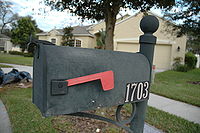 A curbside mailbox of Joroleman design in the United States. When raised, the signal flag indicates outgoing mail.
A curbside mailbox of Joroleman design in the United States. When raised, the signal flag indicates outgoing mail.
A number of postal services around the world are adopting neighborhood or community mail delivery, in which recipients retrieve their mail from an individual letterbox at a centralised or community mail delivery station located in their building or immediate neighbourhood.
A number of designs of letterboxes and mailboxes have been patented, particularly in the United States.
History
Europe
Private letterboxes or mail slots did not become popular in most of Europe until the mid to late 19th century, although they were used in Paris, France from the late 18th century.
In 1849, the British Post Office first encouraged people to install letterboxes to facilitate the delivery of mail. Before then, letterboxes of a similar design had been installed in the doors and walls of post offices for people to drop off outgoing mail. An example of such a wall box (originally installed in the wall of the Wakefield Post Office) is dated 1809 and believed to be the oldest example in Britain.
North America
In the late 18th century, a mailbox was set up at the current location of Boxtree Rd. and Lewis Rd in East Quogue, NY. It is the oldest recorded mailbox in the U.S..
In 1863, with the creation of Free City Delivery, U.S. postal carriers began delivering mail to home addresses. During the nineteenth and early 20th centuries, mailmen knocked on the door and waited patiently for someone to answer. Efficiency experts estimated that each mailman lost 1.5 hours each day just waiting for patrons to come to the door.[3] Slowly, homeowners and businesses began to install mail slots (letterboxes) to receive mail when they were either not at home or unable to answer the door.
To reduce the time required for the mail carrier to complete delivery when the front door is some distance from the street, it was proposed that individual residential or commercial mailboxes be mounted curbside on suitable posts or other supports, particularly in rural areas. In the U.S.A, curbside mailboxes were originally seen as a method of solving the problem of delivering mail with limited numbers of mail carriers using horse-drawn wagons (and later, motor vehicles) to many widely-scattered rural customers. Before the introduction of rural free delivery (RFD) by the U.S. Post Office in 1896, and in Canada in 1908,[4] many rural residents either had no access to public mail delivery, or had to pick up their mail at a post office located many miles from their homes. Consequently, curbside mailboxes did not become popular in North America until free home mail delivery was an established service. Even then, farmers and rural homeowners at first resisted the purchase of dedicated mailboxes, often using empty bushel baskets, tins, and wooden boxes in which to collect their mail.[3] Not until 1923 did the U.S. Post Office finally mandate that every household have a mailbox or mail slot in order to receive home delivery of mail.[3]
Curbside 'full-service' mailboxes were soon fitted with a signal flag or semaphore arm - usually red or fluorescent orange. Originally, this flag was raised not only by the resident of the property to notify the postman of outgoing mail, but also by the postman to inform the recipient that incoming mail had been delivered - a convenience to all during periods of inclement weather.[5][6] One drawback plaguing curbside mailboxes is their potential exposure to damage by motor vehicles. Although some curbside mailboxes are constructed using reinforced materials, even a sturdy brick mailbox can be damaged when struck by an automobile. One noted example of such an incident was the September 2011 collision that damaged the brick mailbox in front of the home of former Miami Dolphins safety Lyle Blackwood.
In 1915, the familiar U.S. curbside Joroleman mailbox with its curved, tunnel-shaped top (to prevent water and snow collection), latching door, and movable signal flag was designed by U.S. Post Office employee Roy J. Joroleman, who held a degree in mechanical engineering.[7][8] Constructed of light-gauge painted sheet steel, Joroleman designed his mailbox with an arched top, which resisted deformation while simplifying the process of production by eliminating the need for precise sheet metal bends. Stamped and formed metal straps riveted to the arched opening and the mailbox door served as a door latching mechanism, while a rotating arm and flag mounted on a shaft attached to the side of the mailbox served to notify the approaching mailman if outgoing mail was inside. Fitted with a crimped or braze-on rear steel panel and a false floor to keep its contents dry in inclement or humid weather, the Joroleman mailbox required only two rivets, three axle bolts, and four screws and nuts for completion. As the Jorolemon mailbox was both durable and inexpensive, it was an ideal choice for the many thousands of family farmers who would soon receive rural free mail delivery in the United States.
Joroleman's design, approved by the U.S. Postmaster General, was eventually released free of charge by the Post Office for inexpensive duplication by mailbox manufacturers; it has been the top-selling U.S. curbside mailbox ever since, and was also widely used in Canada before most rural door-to-door mail delivery was discontinued in that country. The Joroleman mailbox has been both exalted as a supreme manifestation of American functionalist industrial design, and excoriated by others as a 'Quonset hut on a stick'.[7]
In order to promote uniformity, as well as the convenient and rapid delivery of the mail, the United States Post Office Department, (later the United States Postal Service, or USPS) retained the authority to approve the size and other characteristics of all mail receptacles, whether mailboxes or mail slots, for use in delivery of the U.S. mails, and issued specifications for curbside mailbox construction for use by manufacturers. Approved mailboxes from the latter are always stamped U.S. Mail and Approved by the Postmaster General. These standards have resulted in inevitable limitations on product diversity and design, though new materials, shapes, and features have appeared in recent years.[1]
Since 1971, steady increases in postal service costs have motivated the USPS to insist on either curbside or centralized mail delivery for new suburban neighborhoods and developments.[9] The USPS usually makes curbside deliveries to one side of the road only, often requiring elderly or disabled people to cross hazardous busy roads to collect their mail[10] A 1995 cost delivery study published in a USPS Operations handbook listed per-address annual delivery costs as: Door-to-door, $243; Curbside, $154; Cluster Box (centralized mail delivery), $106.[11][12]
A number of designs of mail slots have been patented, particularly in the United States.[13]
Recent developments
In 2001, the USPS first approved designs for locking curbside mailboxes to stem a rise in mail and identity theft.[1] With these secure designs, the incoming mail is placed into a slot or hopper by the mail carrier, where it drops into a secure locked compartment for retrieval by the homeowner (who retains the only key or combination to the lock). Because of the increased risk of vandalism to curbside mailboxes, various vandal-resistant boxes made of resilient plastics or heavy-gauge steel or aluminum plate have also entered the market.
A property containing several homes, apartments, condominiums, or businesses may utilize a community mail station (NDCBU, or Neighborhood Delivery Collection Box Unit), commonly known as a cluster mailbox. These units have multiple compartments for the centralized delivery of mail to the residents of a building or an entire neighborhood, instead of door-to-door or curbside delivery. A parcel locker for receipt of packages and a separate compartment for outgoing mail are usually built into the station.[14] The mail carrier will have a key to a large door on one side that reaches all the compartments, and the residents or tenants will each have a key to the door into their individual compartment on the other side. Recently, the USPS and Canada Post have engendered controversy by aggressively promoting community mail stations or cluster box installations in new suburban developments and some urban and rural areas as well.[15][16][17]
KopparStaden AB, a housing cooperative in Falun, Sweden, has begun to install centralized mail stations with individual letterboxes using electronically-operated doors in its buildings.[18]
Standards
The European standard for letter boxes, EN 13724:2002 "Postal services – Apertures of private letter boxes and letter plates – Requirements and test methods", replaces earlier national standards such as BS 2911:1974 "Specification for letter plates" or DIN 32617. It specifies among other things:
- that envelope size C4 (229 mm × 324 mm) must be deliverable without bending or damage;
- that the internal volume must able to hold at least a 40 mm high bundle of C4 envelopes;
- an aperture width of either 230–280 mm (> C4 width) or 325–400 mm (> C4 height);
- an aperture height of 30–35 mm;
- a mounting height of between 0.7 and 1.7 m for the aperture;
- and various privacy, theft-protection, rain protection, vandalism resistance and corrosion-resistance test requirements.
In the U.S.A., the USPS also has established postal delivery guidelines for its various residential and business customers, including mailbox size, location, and identification requirements.[1][19]
Temperatures
External letter boxes are not temperature-controlled and are sometimes a concern for temperature-sensitive products such as pharmaceuticals. Conditions can include high and low temperatures outside of the recommended storage conditions for some products. For example, the US FDA found the temperature in a mailbox in the sun could reach 136°F (58°C) while the ambient air temperature was 101°F (38°C)[20].
References
- ^ a b c d Postal Service, Code of Federal Regulations 39 CFR Part 111, Standard 7A, Mailboxes, City and Rural Curbside, February 8, 2001
- ^ Canada.com
- ^ a b c Marsh, Allison, Household Mailboxes, National Postal Museum, arago.si.edu
- ^ A Chronology of Canadian Postal History, Rural Free Delivery, civilization.ca
- ^ Blue Mound, Missouri Postal History
- ^ National Postal Museum, Rural Mailboxes
- ^ a b Bernstein, Fred, Public Eye; The Mailbox As Fortress, New York Times, February 25, 1999
- ^ NBNnews.com
- ^ Judis, John B., Mission Impossible, New York Times, September 25, 1988
- ^ Washingtonpost.com
- ^ Pappas, Max. "Cluster Boxes, Not Door-to-Door Delivery". Providence, Rhode Island Journal. http://lexingtoninstitute.org/166.shtml.
- ^ USPS Handbook PO-630, Post Offices Serving DOD Installations, p.47
- ^ Frameless mail slot - Patent D480200; Airtight mail slot - Patent 2437319; Mail slot immobilizer - Patent D443125; Mail slot pouch assembly - Patent 4069965; Mail slot alarm - Patent 5382945; etc.
- ^ "Costly Mailbox Rules Take Effect in September". Nations Building News. http://www.nbnnews.com/NBN/issues/2006-07-24/Multifamily/index.html.
- ^ Rucker, Philip (June 17, 2007). "You've Got Mail, A Block Away". Washington Post. http://www.washingtonpost.com/wp-dyn/content/article/2007/06/16/AR2007061601213.html.
- ^ "Cluster Boxes Replacing Door-to-Door Delivery". Nations Building News. http://www.nbnnews.com/NBN/issues/2006-06-19/Regulation/index.html.
- ^ "Rural Community Mailboxes Unsafe, Say Residents". CBC News. December 7, 2007. http://www.cbc.ca/canada/prince-edward-island/story/2007/12/07/mailboxesdangerous.html.
- ^ Strandberg, Erik, Intelligent Remote-Control Letter Box, Intelligent house
- ^ US Postal Customer guidelines
- ^ Black, J. C.; Layoff, T. "Summer of 1995 – Mailbox Temperature Excurions of St Louis". US FDA Division of Drug Analysis. http://www.layloff.net/articles/1995%20Mailbox%20Temp%20in%20STL.pdf. Retrieved 12 July, 2011.
See also
-
A typical curbside mailbox with store-bought wood post in North Carolina
-
A fantastical mailbox designed by Frederick C. Sauer around 1930 in the Sauer Buildings Historic District in Aspinwall, Pennsylvania
-
Mailbox of Casa de l'Ardiaca, Barcelona, Catalonia, by Lluís Domènech i Montaner
Categories:- Door furniture
- Garden features
- Street furniture
- Postal system
Wikimedia Foundation. 2010.


